Before you go much further let's get one thing clear: I like scooters. I own a scooter. In many ways BMW is preaching to choir in trying to convince me that its new "urban mobility" line is worth considering. Even though I'm already pro-scoot, I approached the U.S. launch event cautiously, remembering that not everyone has reached step-through enlightenment.
BMW's new C600 Sport and C650GT are based on the same platform but differ more than you might think. The instrumentation, wind protection, bodywork, lights, and blinker stalks are unique to their models. Most notably, the entire rear subframe and shape of the tail differs greatly, making a more comfortable passenger perch and increased underseat storage for the C650. The GT also benefits from a slightly wider front profile and an electrically adjustable windscreen (the Sport's adjusts manually), though the extra heft shows in the respective weights. The Sport weighs in at a claimed 549 pounds while the GT tips the scales at 575 lbs. Not exactly featherweights.
Where the C600 and C650 are the same is the motor, despite model names that suggest 50 more cubic centimeters for the GT, and the same drivetrain that includes a centrifugal clutch mated to a continuously variable transmission (CVT). The unit was designed by BMW but is assembled in Thailand by scooter giant Kymco. Options for the C-series are similar, with ABS standard and a Highline Package that includes heated seat/grips, and a tire pressuring monitoring system (TPMS).
Swinging a leg over (or through) a scooter relays a completely different experience from riding a typical motorcycle, from the get-go. Not worse, just different. That being said, riding the C600 and C650 along a twisty road is an admittedly muted feeling. The less aggressive seating position combined with the CVT disconnecting the rider slightly from the drivetrain doesn't quite emulate a motorcycle, but it has to be said that these machines can be ridden quickly with great confidence.
Both models enjoy nimble handling on 15-inch wheels and a tight chassis that inspires more lean angle with every curve. There is plenty of ground clearance, and powerful brakes-two-pot calipers squeeze twin 270mm rotors up front and one in the rear-give the confidence to dive into tight corners. Because there's no clutch to operate, the left lever operates the rear brake, which as an experienced motorcyclist is actually pretty fun. Modulating the brakes independently with each hand is an unusual sensation, but takes up some brainpower and makes the ride more engaging.
The brakes are powerful, but require a solid pull on the levers. We think it's due in part to smaller rotors and calipers than a standard bike, but also because BMW doesn't want to scare off new riders with binders that bite too hard. The Germans have obviously spent a lot of time making sure that the C-series matches the level of refinement and ride quality that BMW customers expect, and it shows. Overall, the C-series offers a whole lot of versatility and performance, whether for everyday commuting, running errands, or even enjoying a mountain road.
Still, we have a few gripes. For example, when the kickstand is deployed it engages a parking brake (nifty trick), but it also kills the engine. Not being able to start the bike when it's on the kickstand is just plain annoying. Not to mention it essentially encourages people to ride off with a cold engine unless the centerstand is used. The other option is to straddle the scoot while it warms up, but with a 31.9-inch seat height (31.3 in. for the GT) and a wide saddle you have to be pretty leggy to confidently manipulate the C-series while stopped for extended periods of time.
The big motor is a little thirstier than the scooter title suggests-BMW claims typical fuel economy of 53 mpg, where a 400cc Yamaha Majesty is rated for 50 mpg and our resident long-term Honda NC700X continues to average 65 mpg in commuting duty. And there is an ergonomic price to pay as well. Because the powerplant is large, it ends up taking up a lot of room underneath the rider and especially in the footwell. Where a normal scooter (think classic Vespa) allows for the rider's feet to be anywhere in the footwell, the BMW has a very tall spine that means placing feet near the outside of the scooter and much more exposed to the elements. The convenience of a low step-through got sacrificed for the performance of a big engine.
For every annoyance there are two hugely pleasing features. Storage, for one, is epic. The C650 GT has more than 60 liters of luggage capacity, and while the C600 Sport is down slightly it does make use of a brilliant feature called the Flexcase. A simple system allows a helmet-sized pouch to drop down from the underseat storage and utilize the space above the rear wheel, but only when the scoot is parked. The main storage compartments also have LED illumination-on both models-that will spoil anyone immediately, especially during ironically named daylight savings time.
This departure from standard motorcycles is an intriguing move for a company like BMW. Most notably, it's a premium brand reaching into a market dominated by an economical ideology. Is it possible for a large, luxurious, and expensive version of a small, cheap vehicle to succeed? BMW obviously thinks that it can. BMW has never made a scooter before, but let's not forget that it wasn't long ago that the company had never built a superbike, either. BMW was also quick to point out that this "urban mobility" line is not just marketing speak for scooters, but rather an expandable genre that will include other "single track" vehicles. Considering the C-series, the resources available to BMW, and its recent track record in expanding horizons, eyebrows have reason to be raised.










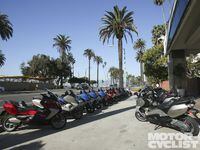
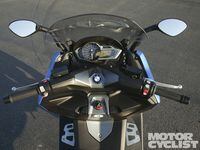

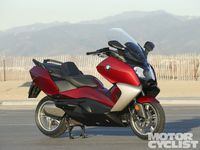



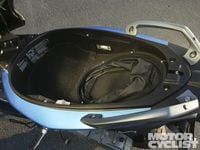
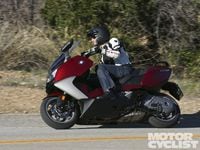
/cloudfront-us-east-1.images.arcpublishing.com/octane/VZZXJQ6U3FESFPZCBVXKFSUG4A.jpg)
/cloudfront-us-east-1.images.arcpublishing.com/octane/QCZEPHQAMRHZPLHTDJBIJVWL3M.jpg)
/cloudfront-us-east-1.images.arcpublishing.com/octane/HXOUJXQWA5HBHGRO3EMJIGFMVI.jpg)

/cloudfront-us-east-1.images.arcpublishing.com/octane/3TIWWRV4JBBOLDVGRYECVVTA7Y.jpg)
/cloudfront-us-east-1.images.arcpublishing.com/octane/KIX5O23D5NAIBGFXBN3327DKZU.jpg)
/cloudfront-us-east-1.images.arcpublishing.com/octane/7GJYDUIPXRGMTMQKN6ONYOLBOU.jpg)
/cloudfront-us-east-1.images.arcpublishing.com/octane/MUQLOVLL2ZDGFH25ILABNBXKTI.jpg)
/cloudfront-us-east-1.images.arcpublishing.com/octane/TNOU5DNE2BC57MFPMGN2EIDXAM.jpg)
/cloudfront-us-east-1.images.arcpublishing.com/octane/GTCXACQGJ5HAPDTGWUQKDEH44E.jpg)
/cloudfront-us-east-1.images.arcpublishing.com/octane/S35YGSEMEZB4BLTDJTSZPF4GLA.jpg)
/cloudfront-us-east-1.images.arcpublishing.com/octane/5UOT6HPX2JFMRJAX6EH45AR4MQ.jpg)
/cloudfront-us-east-1.images.arcpublishing.com/octane/OKWOJWAKP5EP3OACCRRWPCIX2Q.jpg)
/cloudfront-us-east-1.images.arcpublishing.com/octane/2WF3SCE3NFBQXLDNJM7KMXA45E.jpg)
/cloudfront-us-east-1.images.arcpublishing.com/octane/G4MG6OUCJNBSHIS2MVVOTPX65E.jpg)
/cloudfront-us-east-1.images.arcpublishing.com/octane/IIGGWFOTOJGB7DB6DGBXCCMTDY.jpg)
/cloudfront-us-east-1.images.arcpublishing.com/octane/QSTCM6AVEZA5JJBUXNIQ3DSOF4.jpg)
/cloudfront-us-east-1.images.arcpublishing.com/octane/U4I7G625B5DMLF2DVIJDFZVV6M.jpg)
/cloudfront-us-east-1.images.arcpublishing.com/octane/B6XD6LS6IVCQPIU6HXDJSM3FHY.jpg)
/cloudfront-us-east-1.images.arcpublishing.com/octane/ICL63FEDDRDTTMINYICCEYGMDA.jpg)
/cloudfront-us-east-1.images.arcpublishing.com/octane/FCGZHQXRBZFLBAPC5SDIQLVF4I.jpg)
/cloudfront-us-east-1.images.arcpublishing.com/octane/WNOB6LDOIFFHJKPSVIWDYUGOPM.jpg)

/cloudfront-us-east-1.images.arcpublishing.com/octane/X33NU3E525ECRHXLNUJN2FTRKI.jpg)